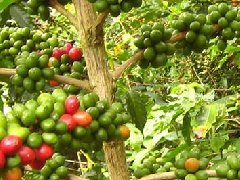Coffee production from the perspective of Colombian coffee: should farmers pursue quality or quantity?

Professional coffee knowledge exchange more coffee bean information please follow the coffee workshop (Wechat official account cafe_style)
The most important discussion in boutique coffee?
Will coffee beans with a score of 85 or higher based on SCAA get a higher price because of their quality? What about miniature plots that require special processing techniques, meticulous sorting and selection of coffee beans after harvest, which may never exceed 10% or 20% of farmers' total output? Of course, the price of these coffee beans will be higher, but will they be more profitable?
Will these boutique coffees be more meaningful to small farmers with limited resources? Or should their scarce capital and labor be better invested elsewhere? The boutique coffee market is mainly aimed at manors, so is it enough to accommodate small farmers and make extensive contributions to the community development and poverty alleviation of cafes? Can farmers turn the improvement of coffee quality into the corresponding improvement of quality of life? Is the standard of quality in the market rising faster than the standard of living in the place of origin?
Is there a point of diminishing returns beyond which additional investment in improving the quality of coffee does not yield a corresponding return? If so, where on earth is this point?
On the rugged hills of Nari ñ o on Colombia's southern border with Ecuador, there may be some answers to these questions.
Should we choose quality or quantity?
The Nari ñ o region has long been considered a source of extraordinary coffee, as evidenced by the results of the 2010 Columbia Excellence Cup: contestants from Nari ñ o swept the top six, with eight places in the top 10 and 17 out of 21.
With this brilliance, it is expected that the Nari ñ o region will produce a large number of boutique batches. In fact, some well-known roasters, including Intelligentsia and PT, have been purchasing miniature batches directly from Nari ñ o in search of higher quality coffee beans.
But most of the coffee in Nari ñ o goes into Nestl é and Starbucks coffee through large purchasing channels, which do not determine how much to pay farmers based on the quality of the cup test.
In this context, farmers need to make a clear choice between two very different business models. One is that it provides a strong price incentive in terms of quality and has nothing to do with quantity to some extent-roasters who purchase directly can buy dozens of bags in large quantities, as long as they can provide coffee that meets their strict quality standards. On the other hand, it is not careless about quality-the coffee beans actually need to meet professional quality standards and the price is reasonable-but it creates a bigger sales incentive: the corporate roasters who dominate Nari ñ o coffee purchases are looking for thousands of bags of coffee beans. For farmers to decide which business model to prefer, it is best to start with their own farms deciding what varieties to grow.
The resistance of Castillo varieties to coffee leaf rust naturally makes it a choice for Colombian farmers looking for maximum yield.
For non-hybrid varieties, the preference of quality-centered bakers makes Kaddura and other traditional varieties the most natural choice for farmers seeking to enter the "boutique" market segment of the professional market.
In fact, Castillo can also get good cup test scores. Direct purchasing bakers who participated in the author's border area standard survey graded some Castillo samples in the mid-1980s, and the Intelligentsia batches of Nari ñ o mentioned above included Castillo varieties. However, bakers who give Castillo samples a score of 86 still prefer Kaddura.
Is there a third way?
Therefore, the best choice for small farmers may not be based solely on quantity or quality, but to seek a compromise between the two. Sweet Maria's Tom Owen put forward a "third way" vision for this excellent theme on coffeed.com. He first acknowledged that the direct trade procurement model of small farmers is unstable, saying that what farmers need is "a certain amount of quality." He advocates the integration of quantity and quality orientation.
"there is a special place to grow Katim, to be honest, it is about 1000 meters above sea level, and the plants are destroyed by coffee rust or other diseases. Bourbon, iron pickup or Kaddura beans cannot survive, even if they are planted, the quality will not be very good. At this time, they should seek the output of coffee there. Maybe they can increase the cup score of coffee beans to 84 with the help of coffee quality research. But where high-quality coffee varieties can be grown, farmers need to use improved methods to maximize the quality, distinguish this level of coffee from poor-quality Arabica coffee and get paid accordingly! "
This approach to farm genetic diversity may actually be the best way for small farmers to manage the production and market risks they face.
To sum up
Nari ñ o is a natural laboratory for studying the returns of small farmers on strategic investments in different varieties and markets.
Some farmers stubbornly insist on growing Kaddura, but others are gradually moving towards the embrace of Castillo. To reduce the risk, some of their farms planted Kaddura and mixed it with Castillo and incorporated it into the Colombian variety, the hybrid precursor of Castillo, which is rust-proof and performs better on cup tests. Some people are looking to maximize profits, while others are deliberately pursuing the cup quality of coffee in order to establish a new and more direct purchasing relationship.
Translated from Daily Coffee News
Important Notice :
前街咖啡 FrontStreet Coffee has moved to new addredd:
FrontStreet Coffee Address: 315,Donghua East Road,GuangZhou
Tel:020 38364473
- Prev

Luckin Coffee has the money to burn again, which is still the money of Starbucks' largest investor.
Professional coffee knowledge exchange more coffee bean information Please follow the coffee workshop (Wechat official account cafe_style) when it comes to Luckin Coffee, the first and most important thing that comes to mind is: does Ruixing still have money to burn today? . It may not be the most important thing whether a cup of American style, latte or even coffee is good or not. If one day, Ray,
- Next

A new way for scientists to identify microscopic worms attacking coffee crops
Professional Coffee knowledge Exchange more information on coffee beans Please follow the coffee workshop (Wechat official account cafe_style) the plant that produces coffee, one of the world's most popular drinks, is the target of miniature worms, but scientists are fighting back. Due to the use of a new rapid detection method, an underestimated coffee planting problem has been found in the soil samples in the field of coffee cultivation. This method
Related
- Why can American refills for free? The difference between Americano and American drip pot coffee
- Being chased out of the rain in front of Starbucks?! Store: Sheltering from rain under umbrellas poses a safety hazard
- The white moonlight has changed?! Lucky launches "Big Winter Pear American"
- Hand-brewed coffee three-stage method, high-sweet and universal brewing method to share! What does the high sweet water level of hand-brewed coffee mean?
- What is the difference between raw, refined and full espresso coffee? How to extract espresso and taste good?
- A complete list of coffee bean names and their meanings! What is Yejia Shefi coffee? Where is Mantelin coffee?
- What grade does Arida Manor Kaduai coffee beans belong to? What treatment is Arida ASD slow anaerobic sun exposure?
- The milk tea cup becomes smaller?! Overlord Tea Girl launches a new "Return to Yunnan" series
- Accused of selling counterfeit and high-priced coffee beans! Well-known boutique coffee brand "Oukelao" bowed and apologized!
- How to make espresso dumplings? Can I eat coffee and glutinous rice balls together?

